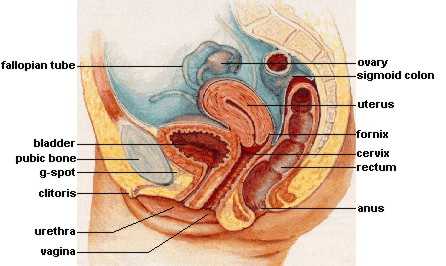Sunday, April 30, 2006
Everything you ever wanted to know about the G-Spot
Everything you ever wanted to know about the G-Spot
What is the G-Spot?
Unlike men, women can orgasm several different ways, via clitoral, vaginal, or G-Spot stimulation. Your partner may already climax fairly easily with clitoral stimulation or during intercourse. However, there is an area for stimulation inside her vagina called the G-Spot that you may not have found. Most people don't know about it. The G-Spot is a bean shaped mass of nerve tissue located about halfway between the back of the pubic bone and the top of the cervix. The G-Spot is the focal point of the female sexual arousal. The size and location of the G-Spot will vary from woman to woman, but it's usually about the size of a quarter, and lies two to three inches inside the vagina directly behind the pubic bone. You may be able to help her have added pleasure, experience new sensations, and perhaps have a new type of climax.
Where can I find the G-Spot?
The G-Spot is not easily located. Sometimes women have a hard time finding it and do not even believe they have one. Here is an easy method to finding it.

Unlike men, women can orgasm several different ways, via clitoral, vaginal, or G-Spot stimulation. Your partner may already climax fairly easily with clitoral stimulation or during intercourse. However, there is an area for stimulation inside her vagina called the G-Spot that you may not have found. Most people don't know about it. The G-Spot is a bean shaped mass of nerve tissue located about halfway between the back of the pubic bone and the top of the cervix. The G-Spot is the focal point of the female sexual arousal. The size and location of the G-Spot will vary from woman to woman, but it's usually about the size of a quarter, and lies two to three inches inside the vagina directly behind the pubic bone. You may be able to help her have added pleasure, experience new sensations, and perhaps have a new type of climax.
Where can I find the G-Spot?
The G-Spot is not easily located. Sometimes women have a hard time finding it and do not even believe they have one. Here is an easy method to finding it.
To explore this area, have your partner lie down, knees bent and feet flat on the bed, with a small pillow under her buttocks. Insert the length of your lubricated fingers into her vagina towards her navel. This will be about two inches inside the vagina. Press with one or two fingers against the front wall of her vagina. Because it's surrounded with tissue and is deep in the vaginal wall, you may want to apply a little more pressure than usual.
When you stimulate the right spot, it will swell the way your penis does. Slide your fingers from side to side. Have your partner tell you when you hit the right place. She will be able to tell. When you find the sensitive spot, continue stimulating it and you may find that it becomes firm and swells much like the erectile tissue in your penis.
How do I stimulate the G-Spot?
Now that you've found the G-Spot, kneeling between your partner's legs you can use the thumb of your other hand to gently stimulate her clitoris at the same time. This combination should give her very intense sensations. She may climax in this position, or you have the alternative of continuing in a different position.
If your partner turns over onto her back, you can stimulate her G-Spot most easily if you lie between her legs. Then try inserting two fingers and rub against the bottom of the vaginal opening, press upward with the tips of your fingers until you are pressing her G-Spot. Move your fingers from back and side to side. You can give her great pleasure by licking your partners clitoris and stimulating her G-Spot at the same time.
Another method is to have your partner lie on her belly with her legs spread apart and her hips slightly elevated. Insert your fingers with your palm down, into her vagina and explore the front wall. Have your partner move her pelvis to make contact with your fingers. As you feel your partner become more aroused, slip the other hand under her abdomen above her pubic hairs and slowly press.
What else is important about the g-spot?
Many women enjoy the "doggy" position during intercourse because it stimulates the G-Spot. This is because a man's penis has better access to the front wall of the vagina. Most women need firmer pressure to the front of the vagina, quick rhythm,and a lot of friction to have a G-Spot orgasm.
Some women get a feeling of the need to urinate at first when the G-Spot is stimulated. Your partner may need to empty her bladder before you begin love making.
It's possible that by stimulating the G-Spot your partner may ejaculate a small amount of white or clear fluid when she climaxes.
Copyright 1998
commentary
The problem between men and woman that men are just into getting satisfied and not satisfying their mates. They do not want to take time to find out how.
It's a shame becuse most men will never find out what kind of sex they will have if they only asked or slow down to find out. They both could be satisfied not just once but every time they had sex.
FOOLISH men. Wake and enjot sex with you partner!
By Herb A Krantz
What is the G-Spot?
Unlike men, women can orgasm several different ways, via clitoral, vaginal, or G-Spot stimulation. Your partner may already climax fairly easily with clitoral stimulation or during intercourse. However, there is an area for stimulation inside her vagina called the G-Spot that you may not have found. Most people don't know about it. The G-Spot is a bean shaped mass of nerve tissue located about halfway between the back of the pubic bone and the top of the cervix. The G-Spot is the focal point of the female sexual arousal. The size and location of the G-Spot will vary from woman to woman, but it's usually about the size of a quarter, and lies two to three inches inside the vagina directly behind the pubic bone. You may be able to help her have added pleasure, experience new sensations, and perhaps have a new type of climax.
Where can I find the G-Spot?
The G-Spot is not easily located. Sometimes women have a hard time finding it and do not even believe they have one. Here is an easy method to finding it.

Unlike men, women can orgasm several different ways, via clitoral, vaginal, or G-Spot stimulation. Your partner may already climax fairly easily with clitoral stimulation or during intercourse. However, there is an area for stimulation inside her vagina called the G-Spot that you may not have found. Most people don't know about it. The G-Spot is a bean shaped mass of nerve tissue located about halfway between the back of the pubic bone and the top of the cervix. The G-Spot is the focal point of the female sexual arousal. The size and location of the G-Spot will vary from woman to woman, but it's usually about the size of a quarter, and lies two to three inches inside the vagina directly behind the pubic bone. You may be able to help her have added pleasure, experience new sensations, and perhaps have a new type of climax.
Where can I find the G-Spot?
The G-Spot is not easily located. Sometimes women have a hard time finding it and do not even believe they have one. Here is an easy method to finding it.
To explore this area, have your partner lie down, knees bent and feet flat on the bed, with a small pillow under her buttocks. Insert the length of your lubricated fingers into her vagina towards her navel. This will be about two inches inside the vagina. Press with one or two fingers against the front wall of her vagina. Because it's surrounded with tissue and is deep in the vaginal wall, you may want to apply a little more pressure than usual.
When you stimulate the right spot, it will swell the way your penis does. Slide your fingers from side to side. Have your partner tell you when you hit the right place. She will be able to tell. When you find the sensitive spot, continue stimulating it and you may find that it becomes firm and swells much like the erectile tissue in your penis.
How do I stimulate the G-Spot?
Now that you've found the G-Spot, kneeling between your partner's legs you can use the thumb of your other hand to gently stimulate her clitoris at the same time. This combination should give her very intense sensations. She may climax in this position, or you have the alternative of continuing in a different position.
If your partner turns over onto her back, you can stimulate her G-Spot most easily if you lie between her legs. Then try inserting two fingers and rub against the bottom of the vaginal opening, press upward with the tips of your fingers until you are pressing her G-Spot. Move your fingers from back and side to side. You can give her great pleasure by licking your partners clitoris and stimulating her G-Spot at the same time.
Another method is to have your partner lie on her belly with her legs spread apart and her hips slightly elevated. Insert your fingers with your palm down, into her vagina and explore the front wall. Have your partner move her pelvis to make contact with your fingers. As you feel your partner become more aroused, slip the other hand under her abdomen above her pubic hairs and slowly press.
What else is important about the g-spot?
Many women enjoy the "doggy" position during intercourse because it stimulates the G-Spot. This is because a man's penis has better access to the front wall of the vagina. Most women need firmer pressure to the front of the vagina, quick rhythm,and a lot of friction to have a G-Spot orgasm.
Some women get a feeling of the need to urinate at first when the G-Spot is stimulated. Your partner may need to empty her bladder before you begin love making.
It's possible that by stimulating the G-Spot your partner may ejaculate a small amount of white or clear fluid when she climaxes.
Copyright 1998
commentary
The problem between men and woman that men are just into getting satisfied and not satisfying their mates. They do not want to take time to find out how.
It's a shame becuse most men will never find out what kind of sex they will have if they only asked or slow down to find out. They both could be satisfied not just once but every time they had sex.
FOOLISH men. Wake and enjot sex with you partner!
By Herb A Krantz
Have you seen a merical today

Have you seen your miracle today?
by Tamar Sofer
Everyone loves a miracle. I've noticed the multitude of new books on small miracles, large miracles, everyday miracles, unseen miracles, and miracles from heaven. Miracles imply that something powerful overrides the natural order of the world. Best of all, a miracle says, we are worth a miracle.
To me, miracles show that someone is definitely in charge here.
Perhaps we do not see miracles anymore. That's why we are publishing so many books on the subject. We need convincing now.
We go about our busy, daily business -- shopping, deadlines, baseball practices -- and we forget to see outside the lines
My husband, a laser physicist, tells me that scientists who study particle physics are more likely to become religious. Scientists are notoriously hard to convince of anything. Yet, when these skeptical scientists see the perfect, natural order of the world, they decide nano and up, that this world was planned. The marvelous design before them becomes the miracle they need to become convinced.
Why then do we need a miracle? Perhaps we do not see the lovely patterns that particle physicists see up close. We go about our busy, daily business -- shopping, deadlines, and baseball practices -- and we forget to see outside the lines. We simply do not notice. Star Trek movies depicted virtual food, but eons before that, the Manna in the Sinai desert had the capability to taste the way the Jews wanted it to, whether it was a charbroiled steak or a piece of brioche. We had to ponder what form the Manna should take before taking that first bite. It was all in the mind, not the software.
Entire spiritual movements have been built around mindfulness, or experiencing the present moment. Staying in the moment is important for prayer; still, when I tried to focus and stay in the moment most the time, I felt unsettled, as if I was stuck in a one-dimensional world. And although many people are leading fulfilling, purposeful lives, they still ask, "Is that all there is to life?". It may well be that when we do not see miracles, we have a vague recognition that something is lacking. What are we missing? How about, everything that happened previously to us?
I look back and see that when my mother died, my aunt moved into place and became the best mother in the world. I look back and see that after 11 years of grueling infertility treatments, the path my son took to his parents became the miracle. Those years taught my husband and me that, as a team, we could accomplish our miracle. And I look back once more and see how I was given the gift of more time. My cancer was found before it inflicted the damage it did to my mother and grandmother, all of us carriers of the dreaded BRCA gene mutation.
I look back and see how, although I was brought to the brink, God held out his finger and I grasped it tightly as he heaved me out of the pit, and handed me my miracle. I see patterns, beautiful, logical patterns that can work with or against the natural order of life. The acknowledgement of those patterns in my life brought me to believe in miracles.
You do not have to be a particle physicist to see miracles. We Jews continuously recount the miracles that led to our nationhood. The splitting of the Red Sea is part of the Jewish national history. This national memory helps Jews believe in miracles, and develop a stronger relationship with God.
We look back and recognize the miracles in our lives. We are very grateful they found us. And then we can look forward, and start creating a world in which miracles are able to flourish. Perhaps, when we all see miracles, these miracles will become part of the natural order of our lives
If you want more information about Jewish thought and religion go to link below
http://www.aish.com
Subscribe to:
Comments (Atom)






